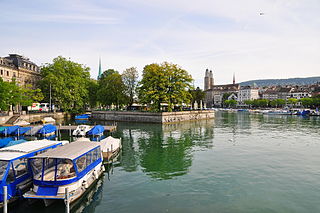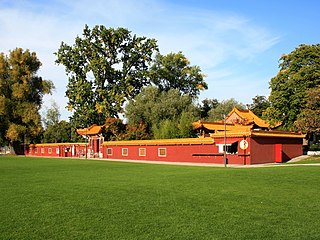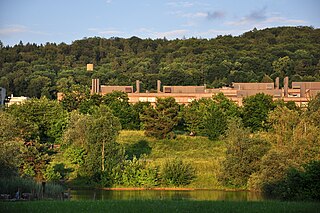 W
WThe Arboretum is a botanical garden, public park and arboretum in Switzerland. The garden is part of the so-called Quaianlagen, a series of lakefronts in Zürich. The area also houses a lido, a public bath with a lake sauna, and the Voliere Zürich including the Vogelpflegestation, a unique sanatorium for birds.
 W
WBauschänzli is an artificial island, town square, and public park in Zürich, Switzerland. Bauschänzli is one of the last remains of the Baroque fortifications of Zürich which began in 1642. The neighboring Schanzengraben (moat) and the Old Botanical Garden are part of these remains. Since 1907, the island has been used as a restaurant, although it is officially a public square and park.
 W
WThe Botanical Garden of the University of Zurich is a botanical garden in the Swiss city of Zurich. It was opened in 1977 and is located at Zollikerstrasse in the Weinegg quarter of the city.
 W
WBürkliplatz is a town square in Zürich, Switzerland. It is named after Arnold Bürkli, and is one of nodal points of the road and public transportation, and of the lake shore promenades that were built between 1881 and 1887. The tree-shaded square between Bahnhofstrasse and Fraumünsterstrasse is called Stadthausanlage.
 W
WThe Chinese Garden is a chinese garden in the Swiss city of Zürich. It is a gift from Zürich's Chinese partner town Kunming, dedicated to the Three Friends of Winter.
 W
WGrün Stadt Zürich, commonly shortened to GSZ, is the Office of Parks and Open Spaces being a service of the Civil Engineering and Waste Management Department of Swiss city of Zürich. Gsz is responsible for creating, preserving and maintaining the city's park system, sports facilities, urban forests, cemeteries, public swimming pools and playgrounds. Ten farms, nine of which are leased out, several nature schools, the local plant nursery, the Succulent Plant Collection and the Chinagarten are also operated, as well as the Quaianlagen promenades at the Zürichsee lake shore.
 W
WThe Gustav-Ammann-Park is a public park in Oerlikon, Zurich, is built on the former area of the Bürhle AG and covers 32,291 ft². In 1996, the privately owned park became a preserve. One year later, the formerly nameless facility was handed over to the population as Gustav-Ammann-Park. It was gently renovated in 2004/2005, maintaining all historical garden monuments. The name of the park reminds us of Gustav Ammann (1886–1955), a well-known Swiss landscape architect who worked in the modernist style.
 W
WIrchelpark is the biggest public park in the city of Zürich in Switzerland, and claims to be the most spacious park in Switzerland.
 W
WLeutschenpark is a public park in the northern Zürich neighbourhood of Leutschenbach. As the main park, the 161,459 ft² Leutschenpark and its flowing shapes bring a new accent to the district which was previously characterized by industry and service buildings. The former industrial and commercial district to the north of Zürich is being transformed into an attractive, mixed neighbourhood for living and working. This also includes first-class open spaces. The park compromises elements of a traditional city park and an urban square.
 W
WThe Lindenhof is a moraine hill and a public square in the historic center of Zürich, Switzerland. It is the site of the Roman and Carolingian era Kaiserpfalz around which the city has historically grown. The hilltop area—including its prehistoric, Roman, and medieval remains—is listed as a Swiss heritage site of national significance.
 W
WThe Louis-Häfliger-Park in Oerlikon, Zurich, covers 5,000 m2 (53,820 sq ft) and is embedded between the Regina-Kägi-Hof co-operative settlement, the existing production buildings for Oerlikon-Contraves AG, and new service buildings. It is a neighbourhood park allowing people who live or work here to relax and meet. The park is named after Louis Häfliger (1904–1993), "Saviour of Mauthausen". He saved the lives of about 40,000 inmates of the Mauthausen concentration camp.
 W
WThe MFO-Park is a public park in the Oerlikon quarter of the Swiss city of Zürich. The area to the north of Zürich Oerlikon railway station was once home to the extensive works of Maschinenfabrik Oerlikon (MFO), as site that has now been redeveloped as Neu Oerlikon. As part of that redevelopment, four new parks were created, including the MFO-Park, which was created on the footprint of one of MFO's buildings. The project was designed by the architects Burckhardt + Partner and landscape architects Raderschallpartner.
 W
WThe Oerliker Park covers 188'000 ft² and was designed as a public multi-purpose district park in Oerlikon just to the north of Zürich. The Oerliker Park was created by the Grün Stadt Zürich in 2001 as part of the regional development project "Zentrum Zürich Nord" and was the first of four parks. The MFO-Park (2002), the Louis-Häfliger-Park (2003) and the Wahlenpark (2005) were built close-by, each of which are matched to local needs as district- and neighbourhood-parks, as well as playgrounds. Taken together, these parks embody contemporary trends of open space planning and landscape architecture. Over the course of the regional development "Zentrum Zürich Nord", the formerly urban and industrial district was given a new face.
 W
WThe Old Botanical Garden is a botanical garden and arboretum in the Swiss city of Zürich. The garden is, among the neighbored Schanzengraben moat and the Bauschänzli bastion, one of the last remains of the Baroque fortifications of Zürich, that was begun in 1642.
 W
WThe Platzspitz park is a park in Zurich, located next to the Swiss National Museum.
 W
WQuaianalagen or Seeuferanlagen on Lake Zürich is a series of lakefronts in Zürich. Inaugurated in 1887, the quaysides are considered an important milestone in the development of Zürich. The construction of the lake fronts transformed the medieval small town on the rivers Limmat and Sihl to a modern city on the Lake Zürich shore. The project was managed by engineer Arnold Bürkli.
 W
WSchanzengraben is a moat and a section of the northwestern extension of the Seeuferanlage promenades that were built between 1881 and 1887 in Zürich, Switzerland. Schanzengraben is, among the adjoint Katz bastion at the Old Botanical Garden and the so-called Bauschänzli bulwark, one of the last remains of the Baroque fortifications of Zürich. The area of the moat is also an inner-city recreation area and, nevertheless, being officially a public park.
 W
WStrandbad Mythenquai is a public bath in the Swiss municipality of Zürich, being part of the historical Seeuferanlage promenades that were built between 1881 and 1887.
 W
WStrandbad Tiefenbrunnen is a public bath in the Swiss municipality of Zürich, being part of the historical Seeuferanlage promenades that were built between 1881 and 1887.
 W
WSukkulenten-Sammlung Zürich, literally succulent plant collection of the city of Zürich, is a botanical garden in the Swiss municipality of Zürich. It also houses a botanic library, a herbarium and the International Organizations for Succulent Plant Research (IOS).
 W
WThe Villa Belvoir respectively the Belvoirpark is a Cultural Heritage in Zürich-Enge that comprises the mansion built between 1828 and 1831, and one of the largest public parks and arboreta in the city of Zürich in Switzerland.
 W
WVilla Tober, also known as the Theater an der Winkelwiese, is a protected building in Zürich-Hottingen that comprises the mansion built in 1853, and a public park.
 W
WThe Wahlenpark is a public park in New Oerlikon in the northern part of Zurich. The park covers 139,931 ft². It was created in 2005 as part of the regional development "Zentrum Zürich Nord", as the last of four parks. The architects envisaged a multi-functional space for play and movement to be used by local residents and young people from the nearby school.
 W
WWerdinsel, also known as Limmatauen Werdhölzli, is an island and protected area in the Limmat in Switzerland.
 W
WZürichhorn is a river delta on Zürichsee's eastern shore in the lower basin of the lake. The area is part of the parks and quays in the Seefeld quarter of the city of Zürich in Switzerland. The gardens are one of the most popular recreational areas within the city of Zürich.